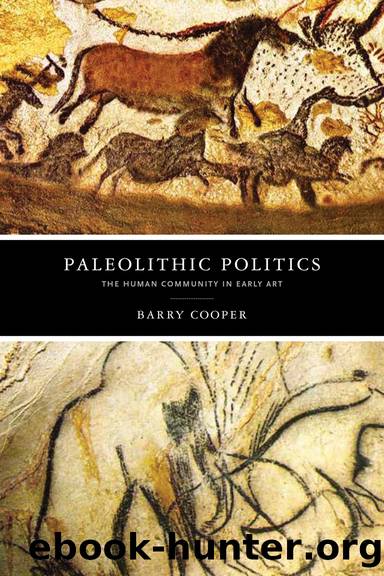Paleolithic Politics by Barry Cooper;

Author:Barry Cooper;
Language: eng
Format: epub
Publisher: Lightning Source Inc. (Tier 3)
Published: 2020-03-20T00:00:00+00:00
THE STRUCTURALISTS
The title of this section refers chiefly to Annette Laming-Emperaire and André Leroi-Gourhan. Many of the scholars who followed Laming-Emperaire in their accounts of Upper Paleolithic paleoscience have used the term âstructuralistâ to describe these two scholars when they extended their surveys beyond the period covered in Laming-Emperaireâs La Signification. Some of these authors link this later work to that of Raphael, who was usually identified as a pioneer of structural analysis or as a structuralist avant la lettre.111 It is possible to recast the question of structuralism in any number of ways,112 but for present purposes it is sufficient to begin with the summary remark of Claude Lévi-Strauss: âScience has only two ways of proceeding: it is either reductionist or structuralist.â113 Neither Laming-Emperaire nor Leroi-Gourhan was a reductionist so, sensu lato, they might as well be considered structuralists.
Such a broad understanding of structuralism, it seems to me, was both what these two scholars had in mind and how they practiced their interpretation. Consider this relatively late remark of Leroi-Gourhan: the âexceptional particularityâ of cave art was that âthe works have remained in the place where the artist created them in often good and occasionally miraculous conditions of preservation. The figures that were engraved, sculpted or painted must have signified something, even if they seem to have been produced without any apparent order. Simply looking at several of the parietal assemblages leaves one with the impression that the significance of the groups of figures would clearly emerge in response to the right questions.â114 A first step in asking the right questions would be to begin with the right assumptions. The most important of these, for Leroi-Gourhan, was that despite the well-marked character of regional styles of art, there was âan underlying cultural unityâ that was expressed in all the decorated caves.115 That is, though separated by great distances in space and millennia in time, the category of âPaleolithic artâ was nevertheless meaningful. No one would mistake the art of Chauvet, Altamira, or Lascaux for that of Miro or Michelangelo. Moreover the endurance of symbolic figuresâa horse or an aurochs, for exampleâdid not imply that the image retained the same meaning, no more than the cross meant the same thing to Catholics and Nestorians.
A second assumption, which was initially made by Raphael and then justified by his narrative of interpretation, was that the cave art constituted a composition. That is, these two scholars assumed that the wall images were deliberately selected and placed in specific locales inside the cave. The images were not therefore independent of one another. Rather, whatever intelligibility that could be found was a consequence of the interrelation of the several individual images that decorated the cave walls. This meant that the interpreter could look for relations among the images as if the ensemble constituted something like a âtext,â a âsystem of signs,â or a âmythogramâ that in turn was governed by a âsyntaxâ that ordered the symbolism in one way rather than another. Moreover, as others
Download
This site does not store any files on its server. We only index and link to content provided by other sites. Please contact the content providers to delete copyright contents if any and email us, we'll remove relevant links or contents immediately.
| Africa | Americas |
| Arctic & Antarctica | Asia |
| Australia & Oceania | Europe |
| Middle East | Russia |
| United States | World |
| Ancient Civilizations | Military |
| Historical Study & Educational Resources |
The Bomber Mafia by Malcolm Gladwell(1179)
Submerged Prehistory by Benjamin Jonathan; & Clive Bonsall & Catriona Pickard & Anders Fischer(1161)
Facing the Mountain by Daniel James Brown(1130)
The Dawn of Everything by David Graeber & David Wengrow(1102)
The Way of Fire and Ice: The Living Tradition of Norse Paganism by Ryan Smith(1030)
Wandering in Strange Lands by Morgan Jerkins(1014)
Tip Top by Bill James(1001)
Driving While Brown: Sheriff Joe Arpaio Versus the Latino Resistance by Terry Greene Sterling & Jude Joffe-Block(1000)
Evil Geniuses: The Unmaking of America: A Recent History by Kurt Andersen(998)
Red Roulette : An Insider's Story of Wealth, Power, Corruption, and Vengeance in Today's China (9781982156176) by Shum Desmond(995)
F*cking History by The Captain(966)
It Was All a Lie by Stuart Stevens;(939)
White House Inc. by Dan Alexander(904)
Evil Geniuses by Kurt Andersen(900)
Treasure Islands: Tax Havens and the Men who Stole the World by Nicholas Shaxson(879)
American Dreams by Unknown(857)
American Kompromat by Craig Unger(847)
The Fifteen Biggest Lies about the Economy: And Everything Else the Right Doesn't Want You to Know about Taxes, Jobs, and Corporate America by Joshua Holland(814)
The First Conspiracy by Brad Meltzer & Josh Mensch(811)
